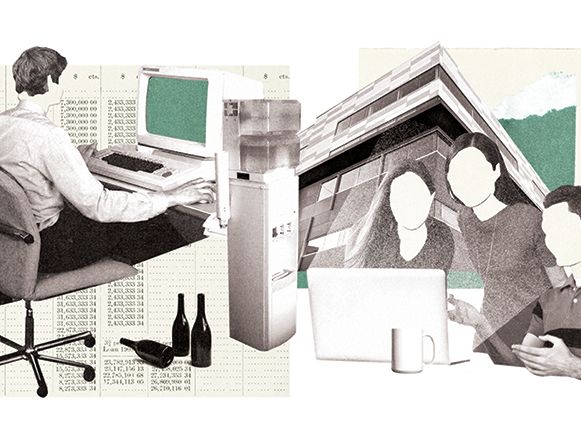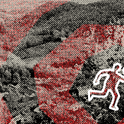As a new graduate in the halcyon final years of the last century, nothing did more to confirm that I’d joined the adult world than my first office job. The building itself played a greater role than the work—fuzzily-defined editorial duties for a publishing firm I’d previously interned with one student summer. Back then the office had consisted of cramped rooms above a boutique off Oxford Street. While I was finishing my degree, however, the company had moved into a shiny glass tower that sprang up on what remains one of the capital’s least lovely thoroughfares.
Each morning I’d stroll from the tube, barely noticing the multi-lane roar of traffic as a montage of clips from films like Working Girl, Broadcast News and His Girl Friday spooled through my mind. The frustration—at once gender-specific and more generalised—that characterises each of those very different portraits of the workplace registered only dimly. Instead, spinning into a gleaming lobby, I felt as though I’d arrived in that larger world, and my reflection seemed to confirm it: edges sharpened by business attire, I was going places. Up to the fourth floor, at any rate, where I’d won my own section of a series of communal desks, small islands overlapped by gym kits, umbrellas, heels—flotsam and jetsam that seemed incongruously personal amid the corporate carpet tiles and panel lighting.
Growing up I had no experience of parents leaving the house to work. Mine are artists, and work was something that took place in the home; there was no work-life balance simply because there was no divide to start with. It was a privileged, precarious way to live, and as much as it made office life thrillingly exotic for me, it also made it hard to settle into, despite my yearning for structure and financial stability. It didn’t help that my duties were so vague. Boredom and anxiety vied with one another, and a lot of time was spent trying to appear busy, clicking between windows on the screen of my hulking computer while blinds blocked the glare from real windows—and a view of construction workers whose labours yielded enviably tangible results, as more office blocks rose up around us.
Meanwhile, endless conversations about holidays booked months in advance stoked a sense of panic; I’d inherited a desk calendar, and the pages already seemed to be flying by too swiftly, while the afternoons crawled. That was another problem: when to go home? The less I achieved, the more reluctant I was to log off, so I appeared most diligent at my least effective.
They were a mostly friendly bunch, my new colleagues, though in the loos I’d overhear conspiratorial sniping suggestive of complicated office politics. Every Friday, rivalries and resentments would notionally be set aside as we gathered in the kitchen area for a boosterish pep talk over large trays of Pret pastries. It was a bonding exercise that felt increasingly hollow as we toiled over proposals whose fate would be determined by a large trade fair, and with them, the future of our jobs.
“Enforced shutdown has shown us there is another way of doing things”
As it turned out, I was gone before the Christmas party, and only one job away from the dicey liberation of self-employment, but it’s a sign of the institution’s might that the office can be almost as defining a fact of life for we solo freelancers as it is for staffers. Physically, it is the place where we aren’t; mentally, our thoughts circle it. We ape its rhythms and routines and find its jargon creeping into our language as we “ping” emails and “circle back” to contacts before “close of play.” Offices shape our cities, too. From Canary Wharf to the Shard and the Gherkin, the most iconic additions to London’s skyline in recent decades have been office buildings, dwarfing the cathedrals and cultural institutions that once dominated. Within, most remain notoriously impermeable to natural light and fresh air. Those who commute to them daily—or did until the pandemic—typically travel at times when transport is heaving with other office workers; they need never see an old person, child or dog during the week, heading home to decompress in front of shows whose dramas and intrigues unfold within the same workplace bubble: Mad Men, Parks and Recreation, Suits.
Even for those of us whose outsider status is flagged by visitor lanyards, a future without the office is hard to imagine. Yet it’s one that company directors, urban planners and policymakers alike are having to envisage in a way few could have imagined 12 months ago. In a year of convulsive upheaval, the demise of the office’s supremacy could become 2020’s most enduring social legacy. When March’s lockdown confined workers to their homes, forcing them to fashion desks from ironing boards and master the art of video conferencing while kid-wrangling, it wasn’t just untended pot plants that withered, it was the office’s unquestioned right—like school for grown-ups—to demand a third of the average white-collar worker’s lifetime.
In truth, in some sectors—like IT, where people would already know about things like Zoom and Microsoft Teams, and are inevitably more attuned to what modern communications can facilitate—a long-anticipated move to working more remotely was already picking up pace. But this is what makes an enforced office shutdown that will not last forever so consequential: everyone now knows that there is another way of doing things. The effect is a bit like it would have been if, during the Blitz, shelled inner-city dwellers had suddenly discovered that the suburbs were already built and ready to move into. A change that could have taken many decades will be dramatically speeded up.
With a second wave of the virus looking like it could stretch the new normal of remote working into a second year, lockdown-hit companies are asking themselves whether they need to renew their old leases. We’re approaching the point where we might need to ask how the office will be remembered. A judicious obituary would acknowledge that the institution provided structure, training, networking and inspiration—even romance—but that those advantages came with some hefty drawbacks: bullying, discrimination, a grinding commute, and the loss of freedom implied by the presumption that one should always turn up.
Unsurprisingly, as early as May, an IBM survey found more than half of US adults wanting to work from home permanently, while three quarters wished to do so at least occasionally. Here in the UK, where workers have been slower to return to the office than their peers in France, Germany, Italy or Spain, a survey conducted in June by academics at Cardiff University and the University of Southampton found that 88 per cent of employees who worked at home during lockdown want to continue to do so in some capacity. For almost half, that meant often or all the time.

Before lockdown, even some of the companies that peddled products that aided working from home, or “WFH,” were themselves reluctant to have staff spend their weekdays anywhere but in centralised hubs, where they could be overseen and more easily managed. That has swiftly changed. At Facebook, tens of thousands of jobs are being shifted to remote work, while Microsoft has announced plans for a “hybrid workplace,” allowing staff to work from home for anything from less than half the week to full time, giving up their permanent desk to take advantage of flexible “touchdown space” as needed. Encouraged by an internal survey that found 90 per cent of staff claiming greater productivity at home, Cloud-storage company Dropbox has announced it will go remote permanently. Its offices, dotted across the US and in Dublin, will be repurposed as flexible co-working spaces for occasional team-building and collaborative work.
For an institution that has had such a defining impact on the lives of generations, the office’s history is surprisingly under-documented. Among the earliest examples is the building that today houses the Uffizi (it translates as “offices”) gallery in Florence, whose construction began in 1560. It was commissioned by Cosimo de Medici as the administrative and legal headquarters of the city, but the ruler understood, too, that it would help to instil a sense of common purpose while doubling as an emblem of his power. A perennial feature of the most ambitious offices—right up to those tall glass and steel towers bearing the names of big banks—is that they are built with a statement the boss wishes to make in mind. The convenience of the worker bees is only a secondary consideration.
But the modern office’s origins are altogether less grand than the Uffizi, and can be traced back to counting houses like the room in which Bob Cratchit clerks for Ebenezer Scrooge. “A dismal little cell” Dickens calls it, “a sort of tank.” These prototype offices weren’t always so grim: they were small, intimate spaces, in which employees and employers sat in close proximity—a distant cry from the human filing cabinets they would later become, with their hierarchical organisational systems.
Change arrived on the heels of the emerging industrial giants, which created added layers of administration; soon, burgeoning paperwork was demanding its own space. Increasingly, white-collar workers (shirts were costly so clerks would freshen up old ones with new detachable collars) were separated from their shop floor colleagues, using different entrances, and then different buildings. Early office workers may have been higher up the class ladder, but in his sharp survey, Cubed: A Secret History of the Workplace, Nikil Saval notes how they became figures of suspicion, especially in America, where they were perceived as unmanly. Not only did clerks dress the part of dandies, and with slender figures and pallid complexions to boot, they failed to produce anything. Instead, they reproduced, endlessly copying records and adding up figures that generated only more records and figures.
The existential disquiet that this stirred has haunted office life ever since, and it’s hard to think of a more striking visual depiction than the opening sequence of Billy Wilder’s 1960 film The Apartment. The office layout at the acutely named “Consolidated Life of New York” is a distillation of the management theories of Frederick Taylor, an engineer whose mania for order and efficiency resulted in evenly spaced rows of workers who filled a single room—essentially open plan, white-collar sweatshops with noise to match once the telephones started ringing and the typewriters clattering. In order to make the vast plain of employees and their ant-like industry seem truly infinite, Wilder sat full-sized desks and actors at the front of the set, followed by suited children at smaller desks, then still tinier desks with little cut-out figures.
Twists in the design sometimes came along to break things up, such as that most maligned, rage-sparking of workplace features, the cubicle. In 1997, the same year that I began my short-lived office career, the cubicle became the backdrop to one of the world’s first viral videos, a 27-second film titled Bad Day, in which a worker takes out his rage on his computer. But of course, there was discontent over “office work” longer than there have been cubicles or offices in anything like the form we know them today. Sat hunched in scriptoria—dedicated workspaces with set hours—medieval monks vented their dissatisfaction in marginalia that has a timeless relatability. “Writing is excessive drudgery. It crooks your back, it dims your sight, it twists your stomach and your side,” grumbles one. Sighs another, to which we all might say amen: “Now I’ve written the whole thing: for Christ’s sake give me a drink.” Centuries later, essayist Charles Lamb, who joined the accounts department of the East India Company in 1792, cavilled extravagantly about life in “official confinement,” telling his friend Wordsworth, “You don’t know how wearisome it is to breathe the air of four pent walls, without relief, day after day, all the golden hours of the day between 10 and four, without ease or interposition.”
Throw together a bunch of people with limited amounts in common, impose a hierarchy and chuck in ennui, perhaps lust, and you’ve got fertile ground for satire, too: whether it’s Scott Adams’s Dilbert, the comic strip destined to adorn mouse mats and mugs, or The Office, whose global franchise testifies to the universality of all that it sends up: the blowhard, incompetent boss, the petty rivalries, the drab romances. (Curiously, both wound up co-opted by the corporate bureaucracies they lampooned—Xerox used Dilbert strips for internal literature, and Microsoft made a training video featuring Ricky Gervais.)
“Now we can leave our desks more readily than ever before, but our devices keep us forever on duty”
But look at The Apartment, and you’ll find a film that also captures some of the aspiration associated with office life. Before disenchantment sets in, Jack Lemmon’s character is sunnily hopeful of promotion, offering a reminder of how, especially in societies still throwing off the presumption that work would be in factories or on the land, the office was a focal point for dreams of respectable prosperity and upward mobility. For a while, it was an equaliser—at least superficially. It allowed everyone to become middle class; it allowed women to enter the peacetime workforce, enabling them to forge an identity outside the home.
Since Wilder made his film, employee churn has sped up. Few folk stick with an employer long enough to become a company man (or woman), and promotion is as often as not achieved via a strategic hop to another company. This heightened agility is just one of the ways in which culture—societal and corporate both—has made the rigidity of the office feel increasingly outdated. The holistic vision pushed by today’s wellness industry, added to millennials’ hunger for varied experiences over promotions and material acquisitions, were undermining the traditional regimens before technology rendered working remotely so practical. Now the pandemic has moved it from borderline acceptable, to mandatory.
What employers expect in turn has also changed, in ways that the spaces in which we labour are often no better equipped to accommodate. As AI makes deep incursions into routine and even cerebral office work, there’s an increased emphasis on creativity and spark, human qualities that our robot competitors find hard to mimic. But even we humans find it hard to scheme for inspiration and imaginative collaboration, and to the extent that companies have tried, it’s left offices filled with distractions like ping-pong tables and gourmet snacking stations. A 2019 Harvard Business Review article cited findings that when firms transition from cubicles to open offices, face-to-face -interactions actually drop by roughly 70 per cent. Long expert at avoiding eye contact on crowded commuter carriages, it turns out office workers are skilled at disappearing in an engineered crowd and erecting their own fourth walls.
And while the office drove the arrival of the photocopier and the water cooler, objects around which we might gather, more recent inventions have been geared to untethering ourselves. Wireless connectivity has meant that we could work just as well in a café or on a park bench. This, too, has changed how we feel about centralised workspaces, because the liberty bestowed by our smartphones and tablets is decidedly double-edged: we can physically leave our desks more readily than before but mentally, those same supposedly freeing devices—often paid for by our employers—keep us forever on duty. (Tellingly, if we trace the etymological root for the word “office” right back, beyond the Uffizi, we arrive at the Latin officium, whose meanings include duty.) You might have thought this blurring of the boundaries between our work and our personal lives could have engendered a nostalgia for the office of old. But in truth, the always on-duty ethos probably means we resent the commute, the micro-aggressions and the confinement all the more.
If ubiquitous WFH is indeed the future, it will have all manner of consequences that we have barely begun to think through. It clearly suits some workers better than others, benefiting those with established careers, networks and personal lives while penalising the ones who are just starting out and might have hoped to develop these things at the office. Then there are the mental health implications and the enhanced burden of multitasking. While some women, for instance, find that being already at home eases the transition into the notorious “second shift” of housework and childcare, others struggle to fence off dedicated worktime. Perhaps the biggest question mark hovers over our cities, and what might become of their centres and financial districts; the countryside would be impacted, too, if no longer needing to be within commuting distance, employees head for the hills. Could that result in a more even spread of talent and wealth, or will people working in divergent domestic circumstances only further stratify our divided society?
Nothing about this social revolution is straightforward. Even the reduction in commuter traffic must be weighed against increased domestic fuel consumption, and the financial ruin that it spells for our public transport system. One thing does seem certain however: WFH is a genie that’s going to be hard to put back in the bottle. This presents a unique opportunity to rethink—and the rethinking is long overdue—what we truly got out of our offices. Companies like Dropbox, whose hybrid vision rescues some of what was valuable about offices without reimposing them as a daily sentence, appear to be onto something. Pre-pandemic there was a boom in shared workspaces, which provide creatives and other freelancers with a perch to borrow when having one is truly worthwhile. The draw of such spaces highlights what we value about them: aesthetics, comfort and community. As many a worker will have discovered this year, an incentive to occasionally get dressed in the morning—and I don’t mean pulling on a jumper over your pyjama top—doesn’t go amiss either.












